So far we have considered the lens to be a single massive object, but if a companion is present in the lens system, the result can be complex and beautiful microlensing light curves.
Understanding binary lenses is the key to the discovery of planetary systems through microlensing.Companions in lensing systems
Authors: R.A. Street
Contributors: Y. Tsapras
The Lens Plane
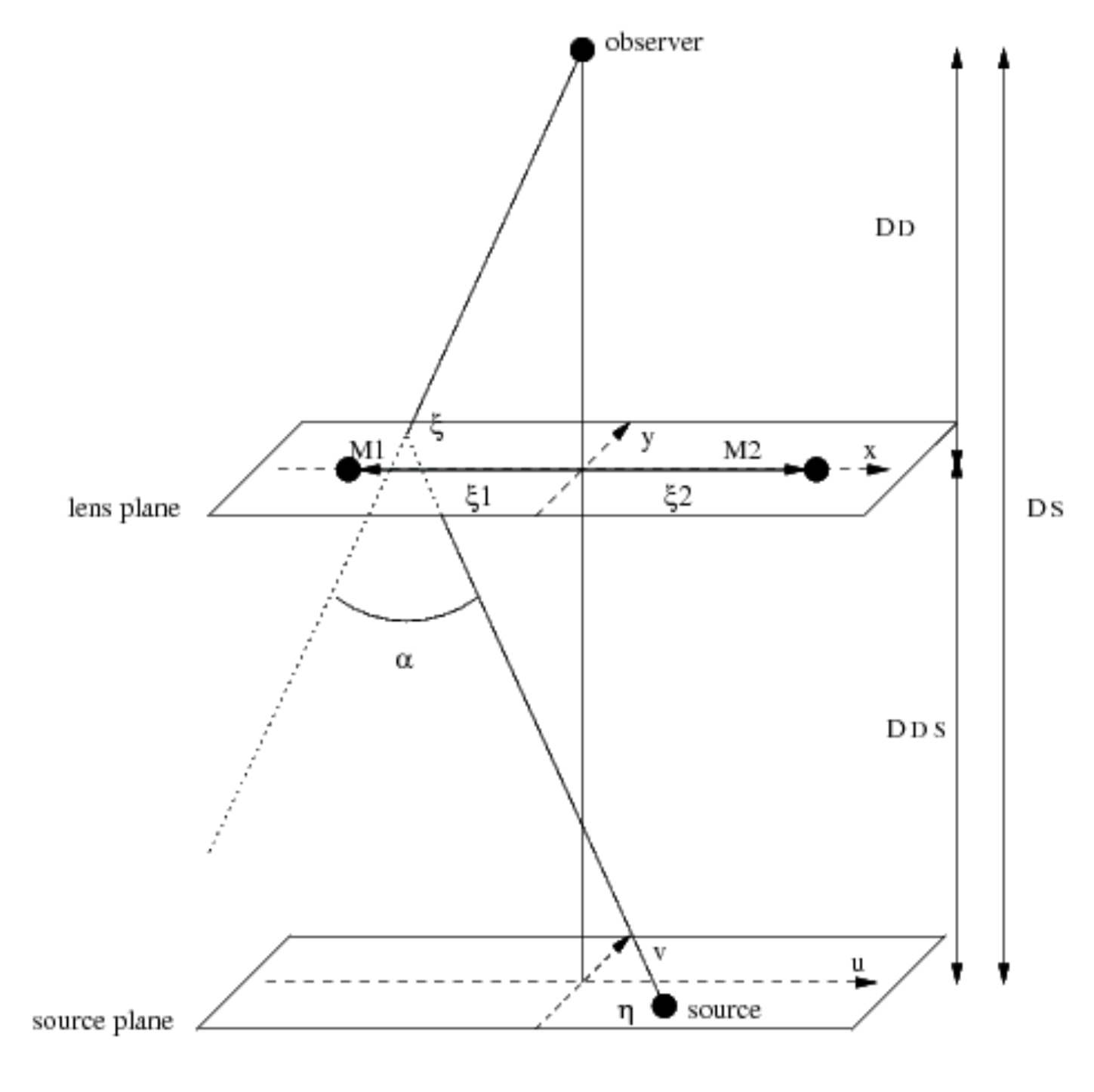
A binary lens has two masses, M1 & M2.
The lens plane coordinate system (x,y) is oriented so that the x-axis passes through the projection of the masses onto the lens plane, with the origin at the central point between the two lens masses.
Both are considered to be at distance DL from the observer, their separation being relatively small.
The Source Plane

The source plane coordinate system, (u,ν), has its origin at the point where the optical axis intersects the source plane.
The optical axis is the line from the observer through the mid-point between the lens masses, so the coordinate system is lens-centric.
Deflection of light by multiple lenses
Each mass deflects a light ray from the source by angle α = 4GM/c2b.
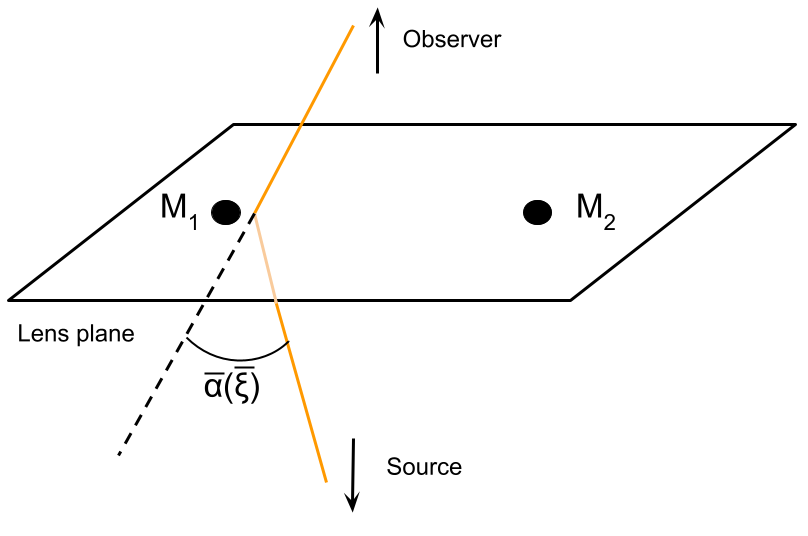
The total deflection is the vector sum of the deflections by each mass.
E.g. a ray which intersects the lens plane at ξ = (x1, y1), has a total deflection for a lens with i = 1 - n masses of:
$$\bar{\alpha}(\bar{\xi}) = \sum_{i}\left( \frac{4GM_{i}}{c^{2}}\frac{\bar{\xi} - \bar{\xi_{i}}}{|\bar{\xi} - \bar{\xi_{i}}|^{2}}\right),$$
The Binary Lens Equation
We now write the lens equation in a form relating the light ray origin in the source plane (η(u,ν)) to the total deflection angle:
$$\bar{\eta} = \bar{\xi}\frac{D_{S}}{D_{L}} - D_{LS}\bar{\alpha}(\bar{\xi}),$$By substituting, we get:
$$\frac{\bar{\eta}}{D_{S}} = \frac{\bar{\xi}}{D_{L}} - \frac{4GM_{1}}{c^{2}}\frac{\bar{\xi} - \bar{\xi_{1}}}{|\bar{\xi} - \bar{\xi_{1}}|^{2}}\frac{D_{LS}}{D_{S}} - \frac{4GM_{2}}{c^{2}}\frac{\bar{\xi} - \bar{\xi_{2}}}{|\bar{\xi} - \bar{\xi_{2}}|^{2}}\frac{D_{LS}}{D_{S}},$$The Binary Lens Equation
This is simplified by declaring:
| $$\bar{w}(u,\nu) = \frac{\bar{\eta}}{D_{S}},$$ | $$\bar{z}(x,y) = \frac{\bar{\xi}}{D_{L}},$$ | $$m_{i} = \frac{4GM_{i}D_{LS}D_{L}}{c^{2}D_{S}},$$ |
and we arrive at:
$$\bar{w} = \bar{z} - m_{1}\frac{\bar{z} - \bar{z_{1}}}{|\bar{z} - \bar{z_{1}}|^{2}} - m_{2}\frac{\bar{z} - \bar{z_{2}}}{|\bar{z} - \bar{z_{2}}|^{2}},$$Mapping between the lens and source planes

This represents a mapping between the source and lens planes:
A light ray from point w̄(u,ν) in the source plane will hit the lens plane at z̄(x,y).
But we are most interested in extracting the locations of the source images in the lens plane geometry.
Locating the source images in the lens plane
As before, solving the binary lens equation gives us the location of the source images.
To achieve this, its convenient to write the lens equation in complex notation
| $$w = z - m_{1}\frac{1}{\bar{z} - \bar{z_{1}}} - m_{2}\frac{1}{\bar{z} - \bar{z_{2}}},$$ | $$w = u + i\nu,$$ | $$z = x + iy,$$ |
where w, z are complex numbers and z̄ is the complex conjugate of z.
Solving this equation requires complex root-finding techniques explored in detail by Schneider & Weiss (1986).
Source Images
Solving this expression for z̄ and substituting, we get (for a binary lens):
$$z = w + \sum_{i=1,2}m_{i}\left[\bar{w} - \bar{z_{i}} + \sum_{k=1,2}m_{k}(z - z_{k})^{-1}\right]^{-1}$$Number of real solutions = number of images of the source
This expression generates a polynomial equation in z of order (n2 + 1), where n is the number of lensing masses.
For a binary lens, there are up to 5 solutions, of which either 3 or 5 may be real, depending on the lens-source projected separation.
Source Images - key takeaways
- Number of images scales with the number of lenses
- Not all solutions are real → not all images exist all the time
- Number and location of images changes with the lens-source projected separation
Magnification for a binary lens
Recall that magnification is the ratio of the lensed/unlensed total image area.
$$A = \left|det\frac{d \alpha}{d \theta} \right|^{-1}$$
Single lens
$$A = \left| det \frac{\partial\bar{w}(u,\nu)}{\partial\bar{z}(x,y)} \right|^{-1},$$
Binary lens
I.e. we calculate the inverse of the area distortion of the lens mapping.
Magnification for a binary lens
The total amplification is given by the sum of the magnification of each image i:
$$A = \sum_{i=1}^{n}A_{i} = \sum_{i=1}^{n}|\det J|^{-1},$$where J is the Jacobian matrix:
$$J = \begin{bmatrix} \frac{\partial u}{\partial x} & \frac{\partial u}{\partial y} \\ \frac{\partial \nu}{\partial x} & \frac{\partial \nu}{\partial y} \end{bmatrix}$$Caustics
As the source moves behind the binary lens, there are certain positions in the source plane for which the resulting Jacobian determinant drops to zero.
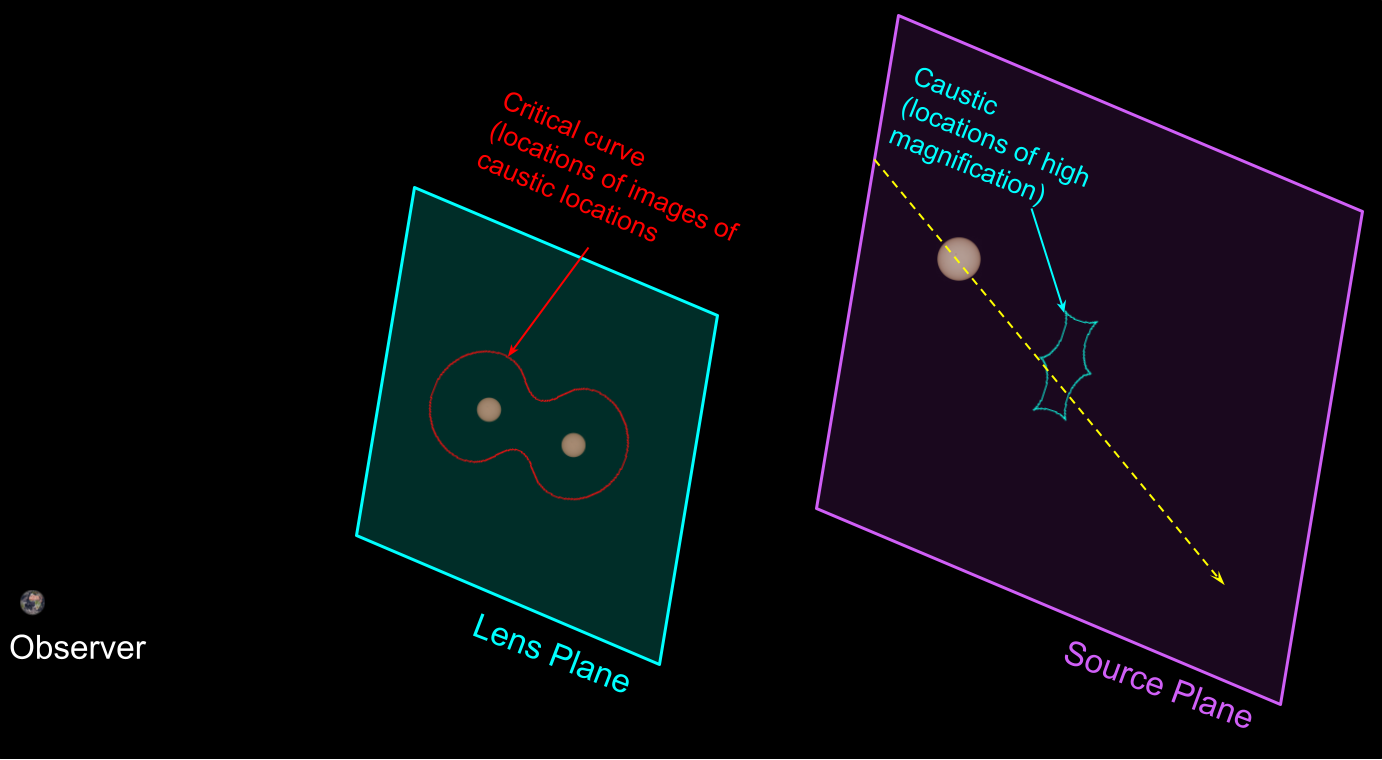
These positions form spikey structures, known as 'caustics'.
Theoretically, as the source crosses these structures, the magnification becomes infinite (curtailed by finite source effects).
Critical Curves

Applying the lens equation, the positions of the caustic in the source plane can be mapped into the lens plane geometry - resulting in graceful curves known as 'critical curves'.
Caustics and lightcurve structure
Number of Lensed Images
- Outside the caustic: 3 images (1 outside and 2 inside the critical curve)
- 2 images exist within the caustic region (1 outside and 1 inside)
- Caustic curve = maximum magnifcation; inside it the magnification can drop
Caustic variety
A wide variety of caustic structures are possible, depending on:
- binary mass ratio
- binary separation
- lens masses' relative angular separation from the source
This simulation has the same parameters as the last one, but M1=0.1, M2=0.9, rather than equal masses
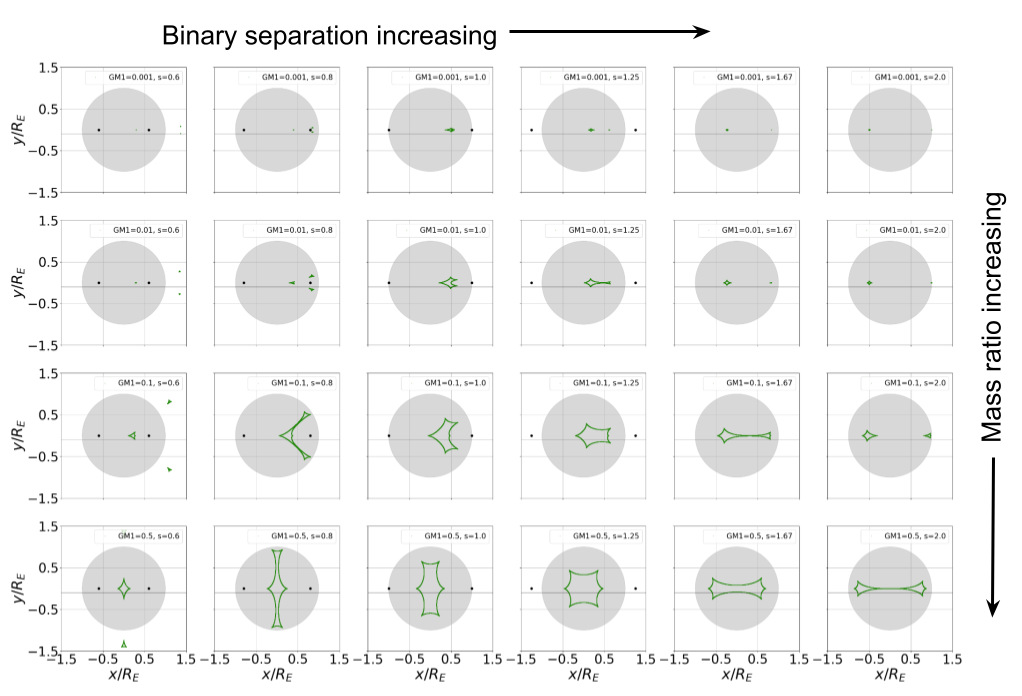
Caustics and Source Trajectories
The source can take any trajectory, relative to the lens geometry, so the lightcurve for the same binary lens can look quite different depending on the angle of incidence.
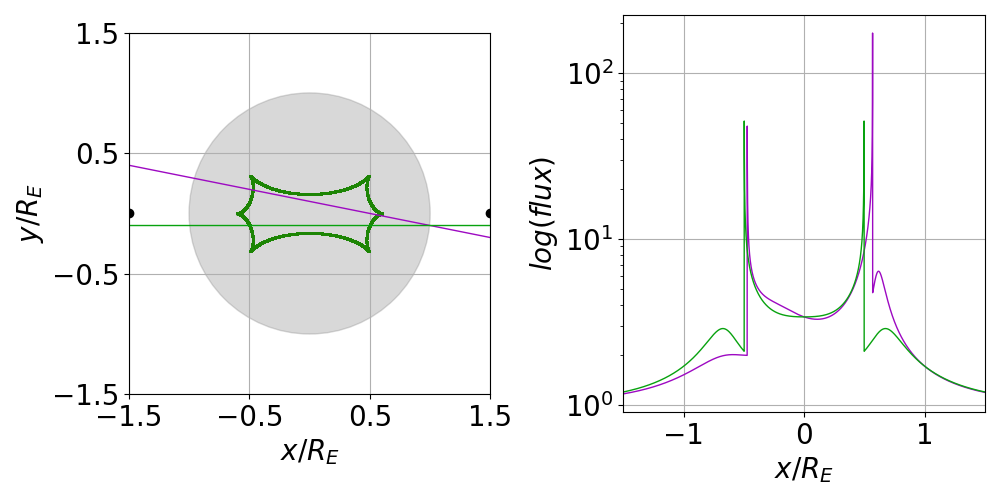
Planetary caustics
Any binary lens will produce caustics.
Provided the source has a favourable trajectory, even an extreme mass ratio binary like a planetary system will produce a detectable magnification.
This makes microlensing uniquely sensitive to even low mass planetary companions.